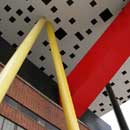Stars + Steel: OCAD
Construction and Erection: The Legs
Special support frames were fabricated to shore the legs during erection. They would not become stable until the truss elements were attached to the top of the legs. These blue frames also required padding on the portions that would come into contact with the legs as these were prefinished with their intumescent coating at the fabrication shop and needed to be protected from damage during erection.
Images: PCL Constructors
These blue frames were custom made by the steel fabricator to shore the legs during erection. They will hold the leg at the required angle until it is secured to the chord of the truss of the table top above. |
|
The support frame in place. Note the padded rests for the legs at the top of the frame. As the incoming elements are prefinished AESS, great care must be taken not to damage the finish. |
|
The frames are ready on the front/east elevation and awaiting the erection of the legs. |
|
A trailer arrives with two legs. In this view you can see the tightness of the site and the limited access. You can also see the padding on the rests at the top of the frame. |
|
This shows the base of the legs. A wide flange section is welded to the bottom of the round base plate. This piece is a key that will be inserted into a recess in the top of the caisson cap and resist lateral forces and slippage. You can also see the temporary steel supports that secure the legs onto the truck. |
|
The crane is beginning to lift the leg. The crane is attached only to the top of the leg for the lift. |
|
The crane operator must be very accurate in order to miss the overhead wires on the street. |
|
When the column is nearly vertical it is eased over to a position that will allow it to be lowered onto the foundation. |
|
Here you can see the reinforced base of the leg as well as the key. The crane is also attached to the column/leg base as the piece cannot be lowered simply by gravity as it must be lowered on the correct angle. |
|
The base is lowered into the recess in the caisson cap and bolted into place. |
|
The columns/legs proceed in conjunction with the expansion of the trusses for the table top. This is a very carefully staged process in order to minimize the need for the truss pieces to cantilever in a temporary position for too long, and also to provide secure attachment for the legs at their top end. |
|
A truss chord is lowered onto two pairs of column legs. |
|
Another pair of legs is in place awaiting further expansion of the table top trusses. Here some additional boom cranes have been brought to the site as the main crane is busy at the north end of the site and cannot reach to the far south end where these are being erected. |
|
The southerly legs are in place and a bottom truss chord attached. The balance of the table top truss chords will be infilled and then extended to the south in their final cantilever position. |
|
A closer view of one of the legs being lowered into the keyway. The placement of the threaded bolts in the caisson cap must align with the holes in the base plate for the column. The fin plates at the base of the column reinforce the connection between the tapered tube and the base plate. This detail will sit below the finished landscape/concrete of the site. |
|
A short clip of the ongoing repair of the intumescent coating on the legs during construction. |
|
